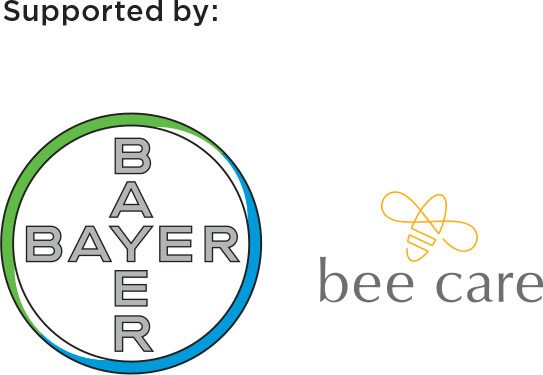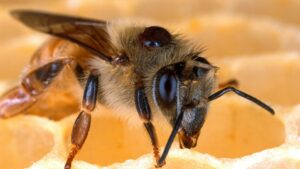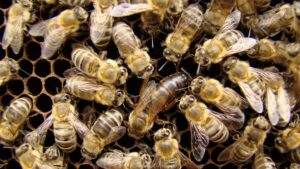Can we build a better bee that is designed to withstand stressors, such as the Varroa mite, American foulbrood, Nosema ceranae and even extreme weather conditions, through genetics?

Duehl, who works to discover new microorganism-based biopesticides to control insects, believes that in the long-term bees will be able to take care of themselves but they need some help in the short term.
“Because bees are so complex, breeders are not necessarily looking for a specific mutation but for whole hive behavior or a suite of different genes,” Duehl says.
For example, researchers at the U.S. Department of Agriculture are working to help bees better cope with the Varroa mite. They can either breed bees to be more tolerant to the Varroa mite, or they can breed bees that have Varroa sensitive hygiene characteristics.
These hygiene characteristics are behavior based, basically meaning that the bees remove larvae infested with mites from the hive. But Duehl says that researchers can’t breed for both resistance mechanisms at the same time — they must choose one. In this instance, USDA researchers chose to focus on hygiene characteristics.
Tom Parisian, a Vacaville, California, beekeeper and cofounder of Honey Bee Genetics, refers to these characteristics as “house cleaning,” where the bees will clean the mites off of themselves and each other and also clean out unhealthy larvae.
Honey Bee Genetics is a stock breeding business, located near the University of California, Davis. Parisian manages the day-to-day aspects of the package bee and queen production, as well as an active pollination service in California’s Central Valley. He knows the importance of having healthy bees.
Cleaning House
Prior to joining Bayer in 2012, Duehl collaborated with the USDA’s Honey Bee Breeding, Genetics and Physiology Research Unit in Baton Rouge, Louisiana, while working at the CMAVE chemistry unit in Gainesville, Florida, as a research entomologist.
QUICK FACT
A queen bee will mate with 15 drones during a mating flight once in her lifetime.
During his time at USDA’s Agricultural Research Service, Duehl was working to try and identify a chemical scent released by unhealthy larvae that causes bees to clean out a cell. “There are bees that uncap cells, smell and depending on if the cell larvae is healthy the bees will either leave it or clean it out,” Duehl says. “We wanted to develop tools to enable individuals with greater sensitivity to the smell to be identified to speed up the breeding process.”
However, these efforts didn’t prove to be fruitful. “We couldn’t do it because we lacked the sensitivity to differentiate the chemicals released,” Duehl says.
Today, there are a number of different laboratories working to breed bees that have Varroa control traits. At the University of Minnesota, researchers are working to find bees that pull out unhealthy larvae. In Baton Rouge, scientists are focused on the Varroa mite.
Additionally, there are Russian bees that are known to be more resistant to mites. These strains are starting to be used commercially but to have locally efficient, fully resistant strains is still in the future, Duehl says.
Honey Bee Genetics offers Russian Carniolan bees, which come from stock brought in from Yugoslavia. Parisian explains that in 1993, Honey Bee Genetics partnered with USDA to breed a “Yugo” Carniolan stock using instrumental insemination (artificial insemination). Five years later, a second group was imported from Eastern Russia. Parisian says that by moving to an area where mites existed, it’s believed Carniolan bees have been parasitized by mites for over 100 years.
“This gentle, gray black bee has shown excellent resistance to Varroa and tracheal mites,” Parisian says. “This means they should not require as much mite treatment as other bee lines. These bees over winter very well and build up fast.”
Beekeepers actively work to breed a number of these genetics into their own stock, while keeping the genetics that thrive in their local region, Duehl says. “For example, the genetics needed for bees to survive in Minnesota are different than that of Baton Rouge,” he says.
The Birds and The Bees
Honeybees have a haplodiploid sex system, which means that if the egg is fertilized, it’s a female bee, and if it’s unfertilized, it’s a male bee. “Many times drones can show uncommon mutations because they only have one set of chromosomes instead of two,” Duehl says.
Queen honeybees take a long time to breed, Duehl says, explaining that once in her lifetime a queen bee flies out to what is known as a drone aggregation area and mates with approximately 15 drones. “So the queen has genetics of many different drones,” Duehl says. “This means that the bees in the hive are actually half siblings instead of full siblings.”
Beekeepers have a tough job, Duehl says. They face a number of new problems that didn’t necessarily exist 20 years ago — Nosema ceranae, the Varroa mite and deformed wing virus. He says other minor pests, such as the small hive beetle in warm, moist regions, are an additional challenge.
In the long-term, beekeepers believe breeding resistance to these pressures is the road to success, but the short-term is very challenging. Beekeepers need access to as many tools as possible.
Bee breeding is a classical art and science. We need to breed bees that are good pollinators, produce lots of honey, are not overly aggressive toward beekeepers and have resistance to Varroa mite and other pests.
Meet the Father of Honeybee Genetics
In 2003, Harry Hyde Laidlaw Jr., who had devoted his life to improving bee health, passed away at the age of 96. Throughout his career, Laidlaw worked for the Louisiana Department of Agriculture, the U.S. Department of Agriculture Southern States Bee Culture Field Laboratory and the USDA Bee Research Lab. Additionally he served as the army’s chief entomologist. He even established a honeybee breeding program for the Egyptian Ministry of Agriculture. In 1947, Laidlaw joined the University of California, Davis, Department of Entomology where he worked for 27 years as a teacher, researcher and publisher. Laidlaw, according to his family, conducted his first experiment with bee mating at the age of 6. His lifetime of research helped bees resist a number of deadly diseases, as well as the Varroa mite. According to Bayer’s Adrian Duehl, a senior scientist in Bayer Biologicals, Laidlaw advanced the science of bee mating and breeding so that scientists can effectively raise lines of bees that are able to resist environmental challenges. “All of this helped him earn his title as ‘the father of honeybee genetics,’” he says.














